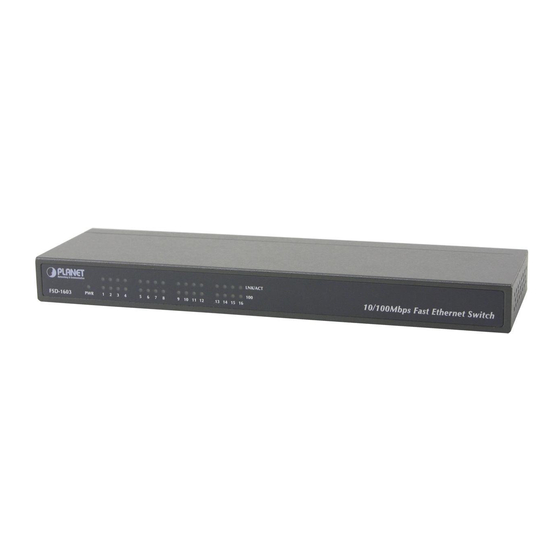Table of Contents
Advertisement
Advertisement
Table of Contents

Summary of Contents for Planet FSD-1603
-
Page 2: Fcc Warning
All other trademarks belong to their respective owners. Disclaimer PLANET Technology does not warrant that the hardware will work properly in all environments and applications, and makes no warranty and representa- tion, either implied or expressed, with respect to the quality, performance, merchantability, or fitness for a particular purpose. -
Page 3: Table Of Contents
About This Guide Chapter 1 Introduction Chapter 2 Unpacking and Setup Chapter 3 Identifying External Components Chapter 4 Connecting the Switch Chapter 5 Technical Specifications Appendix A RJ-45 PIN Specification Appendix B Switch Operation Table of Contents... -
Page 4: About This Guide
100Mbps Fast Ethernet Switch. This device integrates 100Mbps Fast Ethernet and 10Mbps Ethernet network capabilities in a highly flexible desktop package. Purpose This manual discusses how to install your FSD-503/FSD-803/FSD-1603. 5/8/16-port 10/100Mbps Fast Ethernet Switch. Terms/Usage In this manual, the term “Switch” (first letter upper case) refers to your 5/8/16-port 10/ 100Mbps Ethernet Switch, and ”switch”... -
Page 6: Chapter 1 Introduction
For Fast Ethernet networks, a switch is an effective way of eliminating problems of chaining hubs beyond the “two-repeater limit.” A switch can be used to split parts of the network into different collision domains, making it possible to expand your Fast Ethernet network beyond the 205-meter network diameter limit for 100BASE-TX networks. - Page 7 · The Switches are an unmanaged 10/100 Fast Ethernet Switch that offers solu- tions in accelerating small Ethernet workgroup bandwidth.
- Page 8 Other key Features are: · Auto MDI/MDI-X on each port for Uplink to another switch, hub or repeater. · Store and forward switching scheme capability. As the result of complete frame checking and error frame filtering, this scheme prevents error packages from transmitting among segments.
-
Page 10: Chapter 2 Unpacking And Setup
This chapter provides unpacking and setup information for the Switches. Unpacking Open the shipping cartons of the Switch and carefully unpacks its contents. The carton should contain the following items: · One 5/8/16-port 10/100Mbps Ethernet Switch · One external power adapter ·... -
Page 12: Chapter 3 Identifying External Components
Front Panel The figure below shows the front panels of the switches. Please refer to the LED panel section for detailed information about each of the switch’s LED indicators. Rear Panel... -
Page 13: Led Indicators
Note: 1.The Switch is a power-required device, it means, the Switch will not work until it is powered. If your networked PCs will need to transmit data all the time, please consider use an UPS (Uninterrupted Power Supply) for your Switch. -
Page 14: Chapter 4 Connecting The Switch
LNK/ACT lights green, while 100 LED off for hookup to 10Mbps speed. Hub to Switch A hub (10 or 100BASE-TX) can be connected to the Switch via a two-pair Category 3, 4, 5 UTP/STP straight or crossover cable. The connection is accomplished from the hub Uplink (MDI-X) or normal (MDI) port to any of the Switch (MDI/MDI-X) ports: A. - Page 15 Category 3, 4, 5 UTP/STP straight or crossover cable. When using straight or crossover cable, this is done from the any (MDI/MDIX) port of the Switch (Switch A) to any of the 10Mbps or 100Mbps (MDI-X) port of the other switch (switch B) or other devices.
-
Page 16: Chapter 5 Technical Specifications
Operating: 0 ~ 50 degree C, Storage: -10 ~ 70degree C Humidity Operating: 10% ~ 90%, Storage: 5% ~ 90% Dimensions FSD-503/803:160 x 80 x 28 (WxDxH, mm) FSD-1603: 267x 79 x 26 FCC Class B, CE TECHNICAL SPECIFICATIONS 10Mbps (half duplex), 20Mbps Ethernet:... - Page 17 Packet Filtering/ Forwarding Rate: MAC Address Learning: Performance Store-and-forward FSD-503/803: 1-Mbit packet buffer FSD-1603: 4-Mbit packet buffer FSD-503/803: Up to 2K entries per device FSD-1603: Up to 8K entries per device 10Mbps Ethernet: 14,880/pps 100Mbps Fast Ethernet: 148,800/pps Automatic update...
-
Page 18: Appendix A Rj-45 Pin Specification
When connecting your FSD-series 10/100Mbps Ethernet Switch to another switch, a bridge or a hub, a straight or crossover cable is necessary. Each port of the Switch supports auto-MDI/MDI-X detection. That means you can directly connect the Switch to any Ethernet devices without making a crossover cable. - Page 19 There are 8 wires on a standard UTP/STP cable and each wire is color-coded. The following shows the pin allocation and color of straight cable and crossover cable connection: Figure A-1: Straight-Through and Crossover Cable Please make sure your connected cable are with same pin assignment and color as above picture before deploying the cables into your network.
-
Page 20: Appendix Bswitch Operation
Forwarding & Filtering When one packet comes from some port of the Ethernet Switch, it will also check the destination address besides the source address learning. The Ethernet Switch will lookup the address table for the destination address. - Page 21 The Switch performs “Store-and-forward” therefore, no error packets occur. More reliably, it reduces the re-transmission rate. No packet loss will occur. Auto-Negotiation The STP ports on the Switch have built-in “Auto-Negotiation.” This technology automatically sets the best possible bandwidth when a connection is established with another network device (usually at Power On or Reset).
- Page 22 Part No.:2010-000013-101...









Need help?
Do you have a question about the FSD-1603 and is the answer not in the manual?
Questions and answers